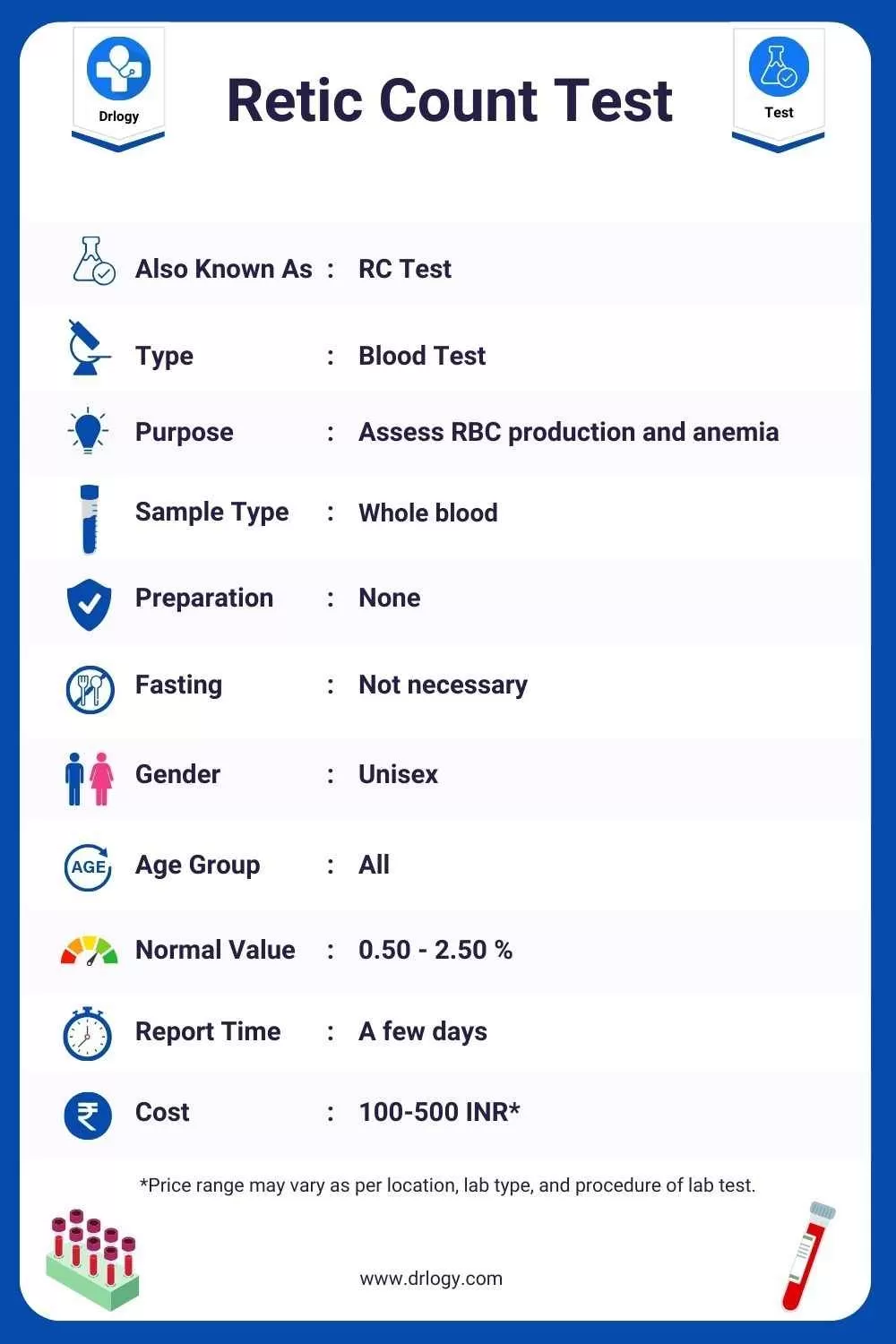
A Retic Count Test is a blood test used to check how well your body is making new red blood cells. It helps diagnose anemia and assess bone marrow function.
Here are the basic details of the Retic Count Test.
| Also Known As | RC Test |
| Type | Blood Test |
| Purpose | Assess RBC production and anemia |
| Sample Type | Whole blood |
| Preparation | None |
| Fasting | Not necessary |
| Gender | Unisex |
| Age Group | All |
| Normal Value | 0.50 - 2.50 % |
| Reporting Time | A few days |
| Cost | 100-500 INR* |
*Retic Count Test Price range may vary as per location, lab type, and procedure of lab test.
Retic Count Test measures the number of young, immature red blood cells in your blood.
The purpose of the Retic Count Test is to:

Here is the basic preparation for the Retic Count Test.
Here is the basic Retic Count Test Procedure.
Here is the normal range of the Retic Count Test.
| Test | Normal Range |
|---|---|
| Retic Count Test | 0.50 - 2.50 % |
Here is the Interpretation of the Retic Count Test.
| Result | Interpretation |
|---|---|
| High count with low RBCs, | Suggests conditions like bleeding or hemolytic anemia, |
| hemoglobin, and hematocrit | where the body compensates by increasing RBC production. |
| Low count with low RBCs, | May indicate issues such as iron deficiency anemia, |
| hemoglobin, and hematocrit | aplastic anemia, or bone marrow failure. |
| High count without anemia | Indicates overproduction, as in polycythemia vera or tumors. |
Interpreting Retic Count Test high may suggest anemia, low may indicate bone marrow issues, while high without anemia could be polycythemia.
| Possible Causes | Description |
|---|---|
| Hemorrhage (bleeding) | Body increases RBC production to compensate for blood loss. |
| Hemolytic Anemia | Increased destruction of RBCs leads to higher production. |
| Hemolytic Disease of the Newborn | Similar to hemolytic anemia, occurs in newborns. |
| Iron or Vitamin B12 Deficiency Treatment | Supplementary treatment may elevate Retic Count Test. |
High Retic Count Test may indicate bleeding, hemolytic anemia, or newborn hemolysis, while treatment can also elevate levels.
| Possible Causes | Description |
|---|---|
| Aplastic Anemia | Bone marrow fails to produce enough RBCs. |
| Iron Deficiency Anemia | Low levels of iron impact RBC production. |
| Pernicious Anemia or Folate Deficiency (untreated) | Vitamin deficiencies affect RBC production. |
| Bone Marrow Disorders | Conditions like leukemia or infections. |
| Chemotherapy or Radiation Therapy | Treatment can suppress RBC production. |
| Severe Kidney Disease | Low erythropoietin levels impact RBC production. |
| Alcoholism | Alcohol can affect bone marrow and RBC production. |
Low Retic Count Test can result from anemia, bone marrow issues, vitamin deficiencies, or certain treatments and medical conditions.
Here are the specimen requirements for the Retic Count Test.
|
Specimen |
Whole blood |
|
|
Volume |
Tube fill capacity |
|
|
Container |
Lavender-top (EDTA) tube |
|
|
Collection |
Invert tube immediately 8 to 10 times once tube is filled at time of collection. |
|
|
Storage |
Refrigerate |
|
|
Sample Stability |
Temperature |
Period |
|
Room temperature |
1 day |
|
|
Refrigerated |
3 days |
|
|
Frozen |
Unstable |
|
|
Freeze/thaw cycles |
Unstable |
|
|
Causes for Rejection |
Hemolysis, clotting, labeling errors, contamination, age, volume, or wrong anticoagulant. |
|
Here is the basic limitation of Retic Count Test.
Here are some of the risk factors of the Retic Count Test.
Here are the Doctor's recommendations or consult a specialist after the Retic Count Test.
| Retic Count Test Result | Doctor to Consult | Reason to Visit |
|---|---|---|
| High | Hematologist | Investigate possible blood disorders. |
| Normal | Primary Care Physician | Routine check or address anemia. |
| Low | Hematologist | Assess bone marrow or anemia causes. |
Here are the estimated Retic Count Test Prices in India with different top cities:
|
City |
Price Range (INR)* |
|
100-500 |
|
|
150-500 |
|
|
100-500 |
|
|
150-500 |
|
|
100-500 |
|
|
150-500 |
|
|
100-500 |
|
|
150-500 |
|
|
150-500 |
|
|
100-500 |
|
|
150-500 |
|
|
100-500 |
|
|
150-500 |
|
|
100-500 |
*Prices are approximate and vary depending on a specific laboratory or healthcare facility.
Summary
Overall, A Retic Count Test is a routine blood test that measures the percentage of immature red blood cells, helping diagnose anemia and assess bone marrow function. Also check Drlogy Test for detailed information about all medical tests for patients, doctors, scholers and medical students.
Reference
DOCTOR'S MOST TRUSTED HEALTHCARE PLATFORM
10M+
Patients
30000+
Doctors
25000+
Hospitals/Labs